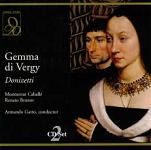Premiered at La Scala in December, 1834 (and immediately following Maria Stuarda), Gemma di Vergy was a hit, running 26 performances before moving all over Italy and the rest of Europe, where it held on for more than 60 years. It then dropped dead, and it was the revival in Naples in December, 1975 for Montserrat Caballé that brought it back, however briefly. Caballé apparently was out of sorts opening night–this recording was made during the second performance on the 12th.
The plot, set in 1428 in a French province, concerns Gemma, who is being dumped by her Count husband (and replaced by Ida) because she cannot produce an heir. Tamas, Gemma’s Arab slave, is in love with her; he kills Rolando, the Count’s major-domo, Gemma pleads for his life and he is pardoned. In Act 2 Gemma tries to kill Ida but Tamas stops her; he then kills the count during the Ida/Count wedding ceremony. Gemma goes half-mad with despair, Tamas kills himself, Gemma yearns for death. It’s not for nothing that an English critic, in 1842, called the plot “sickly and improbable”. The opera’s best music is the long first finale, a trio/quartet in Act 2, and Gemma’s big final scene.
The title role is very difficult, lying in the passagio–that dangerous F-G-A range going up the staff–with some much higher outbursts. By the second performance, Caballé was back on form, but not entirely: she ducks some high notes, others can be a bit raw, and at times she resorts to vocalizing rather than articulating the words, which tends to make vocal production more challenging. But in general, those long-arched phrases and gorgeous pianissimos for which she’s famous are here to be savored. (There exists a recording of this opera from the following year, in Paris, in which she’s in better voice–but it seems to be unfindable. She also sang it in New York and Barcelona a couple of times before deeming it too difficult–“the equivalent of singing three Normas.”)
As the wicked if one-dimensional Count, baritone Renato Bruson is at his finest, singing with a smooth-as-silk legato, perfect round tone, and even a swell, interpolated high-A at the end of his second-act cabaletta. Tamas is tenor Giorgio Casellato Lamberti, and he sings with conviction and manly tone, making what he can of this noble if misdirected character. The rest of the cast is good enough. Conductor Armando Gatto whips the orchestra and singers into a proper frenzy in the big numbers, and elsewhere he’s considerate–almost to a fault–of Caballé. For a Donizetti completist this recording is crucial; and at this price, why not add another, sometimes-very-impressive bel canto opera to your collection?
































